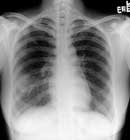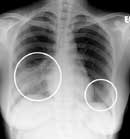
Issue No 6: May 2003
![]()
Scientists at Hong
Kong universities reacted swiftly to the SARS (Severe Acute Respiratory
Syndrome) crisis.
![]() Working
day and night, they followed a number of leads in an attempt to identify
the cause of the disease which is threatening the world.
Working
day and night, they followed a number of leads in an attempt to identify
the cause of the disease which is threatening the world.
![]() Microbiologists
at The University of Hong Kong announced that the primary agent involved
in the atypical pneumonia epidemic is a coronavirus which is usually found
in animals.
Microbiologists
at The University of Hong Kong announced that the primary agent involved
in the atypical pneumonia epidemic is a coronavirus which is usually found
in animals.
![]() The
finding was independently confirmed by the Centers for Disease Control
and Prevention in the US, and the World Health Organization (WHO).
The
finding was independently confirmed by the Centers for Disease Control
and Prevention in the US, and the World Health Organization (WHO).
![]() Some
of the first radiological findings of SARS were provided by The Chinese
University of Hong Kong’s Department of Diagnostic Radiology and
Organ Imaging which has been working closely with a WHO collaborative
network of research centres.
Some
of the first radiological findings of SARS were provided by The Chinese
University of Hong Kong’s Department of Diagnostic Radiology and
Organ Imaging which has been working closely with a WHO collaborative
network of research centres.
![]() Researchers
worked with medical taskforces at local hospitals which were swamped with
SARS cases. The disease can be transmitted by respiratory droplets over
short distances of about one metre, or by contact with a patient’s
respiratory secretions.
Researchers
worked with medical taskforces at local hospitals which were swamped with
SARS cases. The disease can be transmitted by respiratory droplets over
short distances of about one metre, or by contact with a patient’s
respiratory secretions.
![]() With
the epidemic spreading, the WHO issued a global health alert on 12 March.
With
the epidemic spreading, the WHO issued a global health alert on 12 March.
![]() Various
countries installed health checks on visitors inbound from SARS-affected
areas and put in place other precautions in an attempt to protect their
populations.
Various
countries installed health checks on visitors inbound from SARS-affected
areas and put in place other precautions in an attempt to protect their
populations.
![]() Said
RGC chairman Prof Kenneth Young: “Scientists in the local universities
reacted to the crisis swiftly and professionally. Within a fairly short
time, they successfully identified viruses which were possibly responsible
for the mysterious disease.
Said
RGC chairman Prof Kenneth Young: “Scientists in the local universities
reacted to the crisis swiftly and professionally. Within a fairly short
time, they successfully identified viruses which were possibly responsible
for the mysterious disease.
![]() “The
speed with which the Hong Kong scientists accomplished this illustrates
clearly Hong Kong’s excellent research capability.”
“The
speed with which the Hong Kong scientists accomplished this illustrates
clearly Hong Kong’s excellent research capability.”
![]() Prof
Young added: “Robust research is not established overnight. The infrastructure,
research teams, and the expertise have to be built up and developed over
time.”
Prof
Young added: “Robust research is not established overnight. The infrastructure,
research teams, and the expertise have to be built up and developed over
time.”
![]() RGC
records show that more than HK$42 million has been allocated to institutions
over the years to support research related to studies of viruses and pathogenesis.
RGC
records show that more than HK$42 million has been allocated to institutions
over the years to support research related to studies of viruses and pathogenesis.
![]() “I
think this epidemic argues strongly for the case that research as well
as research personnel must be nurtured and developed across a broad front,”
said Prof Young.
“I
think this epidemic argues strongly for the case that research as well
as research personnel must be nurtured and developed across a broad front,”
said Prof Young.
![]() “It’s
a good example of how the stock of knowledge and accumulated experiences
can at some future point in time become very relevant to our everyday
needs.”
“It’s
a good example of how the stock of knowledge and accumulated experiences
can at some future point in time become very relevant to our everyday
needs.”
![]() In
1997, Hong Kong scientists detected the H5N1 virus responsible for an
outbreak of avian flu which led to the deaths of six people and the culling
of about 1.4 million chickens.
In
1997, Hong Kong scientists detected the H5N1 virus responsible for an
outbreak of avian flu which led to the deaths of six people and the culling
of about 1.4 million chickens.
![]()
 |
 |
| Images of SARS progressing over four days in a 27-year-old female patient - supplied by CUHK. |
 |
| Coronavirus organelles attaching themselves to a cultured cell - supplied by HKU. |